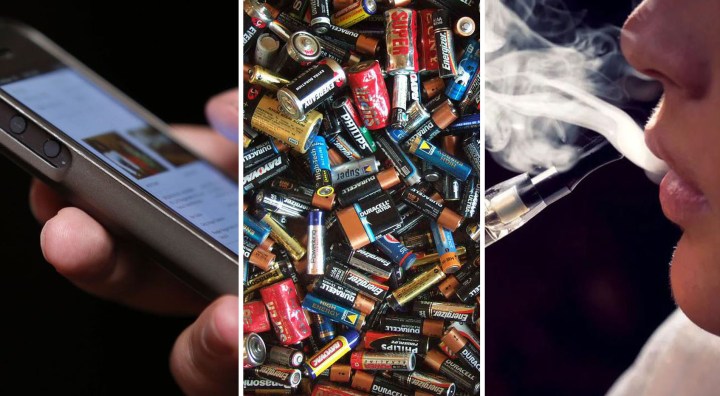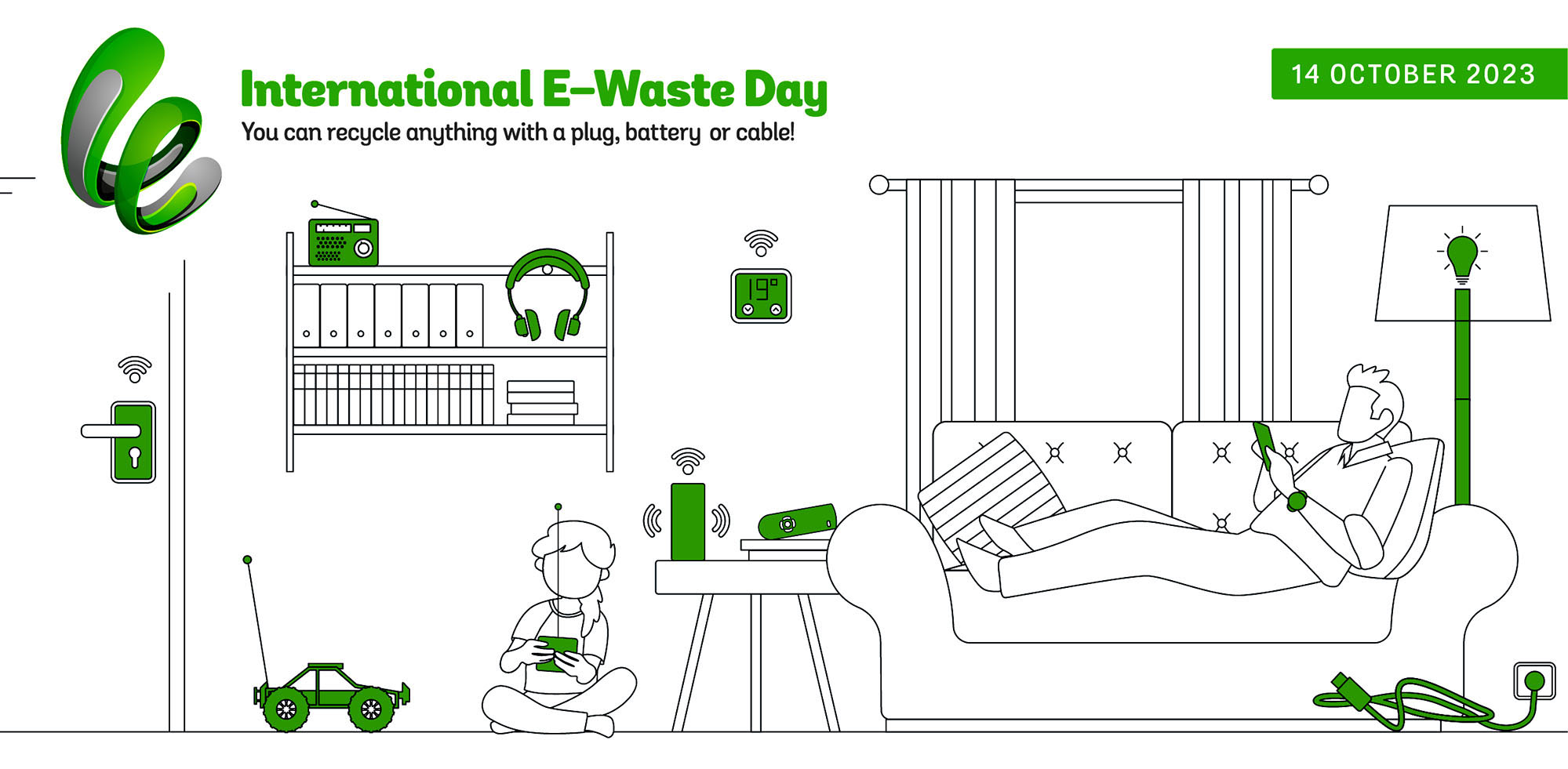E-WASTE SOLUTIONS
There are good reasons for recycling that old vape or iPhone lying in your drawer

E-waste is the world’s fastest-growing waste stream. But one-sixth of it is invisible to us and will either prove hazardous in a landfill or be a wasted precious resource.
On average, every one of us will produce eight kilograms of e-waste (electronic waste) this year, according to the United Nations.
The problem is that only 17.4% of this waste – which contains harmful substances and precious materials – will be properly collected, treated and recycled globally. The remaining tens of millions of tonnes will be placed in landfills, burnt, illegally traded, improperly treated or hoarded in households.
One-sixth of all electronic waste by mass – nine billion kilograms per year – goes largely unrecognised by consumers as e-waste, according to the Waste Electrical and Electronic Equipment (WEEE) Forum.
This is equivalent to half a million 40-tonne trucks; enough to form a 5,640km bumper-to-bumper line of trucks from Rome to Nairobi.
The WEEE Forum, which organises the annual International E-Waste Day that took place for the sixth time last Saturday, commissioned the United Nations Institute for Training and Research to calculate the annual quantities of “invisible” e-waste items.
They found that in South Africa alone, 63 million tonnes of e-waste – 151 million pieces (excluding cables) – went unidentified in 2022.
The study also found that 950 million kilograms of cables containing precious, easily recyclable copper were discarded last year – enough cable to circle the Earth 107 times.
What is e-waste?

(Image: WEEE Forum)
“Anything that works with an electric pulse, a plug or battery is e-waste,” Ashley du Plooy, CEO of the E-waste Recycling Authority, told Daily Maverick.
This includes small things like cables, e-toys, e-cigarettes, batteries, LED lights, blenders, radios, laptops, earphones, power tools, USB sticks, and wearable health devices; medium things like e-bikes, smoke detectors, air-fryers and microwaves; and large things like washing machines, stoves, fridges and even solar energy equipment and batteries.
“Many people don’t recognise some battery-powered or wired-in products like a smoke detector or smart thermostat as an electrical product because they don’t have a plug,” Pascal Leroy, Director-General of the WEEE Forum said.
“They are also unaware of the hazardous components e-waste contains.”
Why recycle e-waste?
Two main reasons: e-waste ending up in landfills can be hazardous; and you will be throwing out precious resources, which are crucial for the green transition and production of new electronic devices.
Electronics contain hazardous substances such as lead, mercury, cadmium and flame retardants, which can leach into soil and water sources, pollute ecosystems and pose risks to human health.
Many of our devices, such as vapes – the use of which is seriously on the rise – contain lithium, which makes their battery rechargeable but also poses serious fire risks because it burns in the presence of oxygen.
Du Plooy explained that along with having limited landfill space, e-waste items accumulating in one space is dangerous, because once there is an aggregate of electronics (like 20,000 cellphones sitting together), there is a risk of batteries leaking.
“The aggregation of all those minor risks sitting together in one space, makes it a colossal risk,” explained du Plooy, adding that their biggest challenge – along with specific toxicities like lithium-ion batteries and the refrigerant in refrigeration equipment – is actually mixed plastics, which can’t be recycled and take decades to degrade.
“It’s not just that they might be dangerous or harmful to the environment – leaving them in your garage or drawer means there’s a loss of resources that could have been recovered,” Patricia Schröder, the CEO and spokesperson of Circular Energy, told Daily Maverick.
Our electronics contain valuable resources, including precious metals like gold, silver and copper, and critical raw materials – so when e-waste is not recycled correctly or ends up on the street or in landfills, these valuable materials go to waste.

Metal ingots recovered from processed e-waste materials. (Photo: Ashley du Plooy)
According to WEEE, the value of raw materials in e-waste generated globally in 2019 was estimated at $57-billion, mostly attributed to iron, copper and gold components.
Of the overall total, a sixth, or $9.5-billion in material value each year, is in the invisible e-waste category.
“A finite amount [of rare earth metals used in solar panels and batteries] is available on the planet,” said Schröder.
“So if we recover those resources and we reuse them – because they can be reused indefinitely – then you have an infinite source.”
“It’s the extraction of those materials, and particularly the metals, that can be reused in the manufacture of new products,” agreed Du Plooy, who has decades worth of experience in the industry.
“What we are doing, in a sense, is above-ground mining,” he said. “So it saves on the mining of virgin materials.”
Additionally, when consumers leave their e-waste products at drop-off points, “not only are you contributing to resource recovery and circular economy principles, but you’re also contributing to supporting jobs and job growth in the waste management sector,” said Schröder.
Du Plooy agreed: “It’s very important that we work on creating markets for these fractions that come out of electronic waste.
“Electronic waste is the most complex product… in one cellphone you have a myriad of materials.”
We hoard these items thinking they hold value, but, as Du Plooy explained, “the longer it takes for those phones to be recycled, the less they are usable or repairable.
“If you’re sitting with a 20-year-old Nokia, it’s almost a completely useless piece of equipment in the context of where cellphones are going now.
“So the sooner the electronic waste is made available for recycling or repair or reuse, the sooner it can reenter the market.”
Extended Producer Responsibility
“For the government and for municipalities to deal with electronic waste is a challenge. It’s a challenge just to deal with solid municipal waste,” said Du Plooy, explaining that the government is applying the “polluter pays” principle in terms of the Extended Producer Responsibility (EPR) regulations.
EPR is a policy approach that shifts responsibility to the producer when it comes to waste management. Part of the National Environmental Management: Waste Act, these regulations were published in May 2021 and became effective in November of that year.
After registering with the Department of Forestry, Fisheries and Environmental Affairs (DFFE), producers are required to either submit their compliance schemes or join a Producer Responsibility Organisation (PRO) to execute their role of financing the extraction, collection, recycling and disposal of the waste generated by their products.
“[This policy] recognises that those who put products on the market must be responsible for the safe extraction of those products from the market when they come to the end of life,” explained du Plooy.
Both Du Plooy’s company, E-waste Recycling Authority and Schröder’s company, Circular Energy, are not-for-profit Producer Responsibility Organisations and are WEEE Forum members.
“Globally, EPR systems have been running quite successfully,” said Schröder. “And the ones that failed are because of lack of governance or bad governance.”
In Europe, thanks to 20 years of EPR legislation, 55% of e-waste generated is now officially collected and reported.
Still, according to the United Nations global e-waste monitor, other parts of the world show much slower growth rates in its collection, and globally, the reported average collection rate is just over 17%.
Less than 10% compliance in SA
Schröder, who has more than 15 years of experience in the e-waste sector and more than 30 years of experience in the environmental management sector, explained, “Producers have to comply under the EPR regulations – it’s a criminal offence, should they not comply. And they are enforcement actions… but compliance rates in SA right now are very low.”
Du Plooy said that only 10% of producers are compliant in South Africa.
Schröder explained that like all departments, the DFFE doesn’t have the resources to go after the thousands of companies that are non-compliant, so they are building systems to manage noncompliance and are working with Sars and customs.
Consumer responsibility
While the EPR policy shifts the responsibility to the producer, Du Plooy and Schröder made it clear that consumers still have a responsibility in the e-waste cycle.
“It starts with consumer choice,” said Schröder.
“We should choose products that are managed correctly or are easily recyclable. Then, once we have finished with our gadget, take responsibility and get that product managed effectively and environmentally soundly.
Consumers can drop off their e-waste at drop-off points managed by PROs or request to have their e-waste collected. These take-back schemes are often managed by PROs.
Schröder explained that the consumer has the right to return identified products listed in the regulations to the producer.
Where can you drop off your e-waste?
The E-waste Recycling Authority has partnered with Makro and Builder’s Warehouse and is looking at establishing 300 to 500 drop-off points in the next two years.
Circular Energy has partnered with Woolworths (you can drop your e-waste at most of the 500 Woolies stores nationwide), and their recycler service providers have over 700 drop-off points in the country. It also has a service where you can request a collection of old appliances and other e-waste from your home. DM






















 Become an Insider
Become an Insider
i’ve been searching in vain for a place to drop off used batteries (aaa and aa). it’s tough to recycle these things when finding somewhere to drop them off is so tough.
Exactly. Woolworths says they take them but when you arrive there they look at you blankly, especially if you don’t live in a main centre. How are you supposed to drop off a lawnmower or electric drill at builders?
Great Article, Julia. Thank-you. It would be great to have contacts for the reliable e-waste collectors . Do you know if a national database exists ? I wonder if Woolworths knows of the frustrations expressed in the responses.